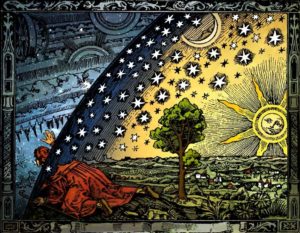Madness, too much time in the desert or just the right hallucinogenic concoction all seem to be reasonably reliable routes to mysticism. Ayahuasca is (the New Yorker reports) “an intensely hallucinogenic potion made from boiling woody Banisteriopsis caapi vines with the glossy leaves of the chacruna bush” an—bonus—it comes with added ‘indigenous’ chic.
The story begins with some Americans wandering through the Amazon (of course it does) in the early 1970s (of course it did).
[T]he travellers found themselves in a psychedelic paradise. There were cattle pastures dotted with Psilocybe cubensis—magic mushrooms—sprouting on dung piles; there were hammocks to lounge in while you tripped; there were Banisteriopsis caapi vines growing in the jungle. Taken together, the drugs produced hallucinations that the brothers called “vegetable television.” When they watched it, they felt they were receiving important information directly from the plants of the Amazon.
The McKennas were sure they were on to something revelatory, something that would change the course of human history. “I and my companions have been selected to understand and trigger the gestalt wave of understanding that will be the hyperspacial zeitgeist,” Dennis wrote in his journal. Their work was not always easy. During one session, the brothers experienced a flash of mutual telepathy, but then Dennis hurled his glasses and all his clothes into the jungle and, for several days, lost touch with “consensus reality.” It was a small price to pay. The “plant teachers” seemed to have given them “access to a vast database,” Dennis wrote, “the mystical library of all human and cosmic knowledge.”
Hyperspatial zeitgeist. Consensus reality. Plant teachers. The mystical library of all human and cosmic knowledge.
The New Yorker:
Most people who take ayahuasca in the United States do so in small “ceremonies,” led by an individual who may call himself a shaman, an ayahuasquero, a curandero, a vegetalista, or just a healer. This person may have come from generations of Shipibo or Quechua shamans in Peru, or he may just be someone with access to ayahuasca.
Naturally, wicked Western materialism takes a knock:
Ifcocaine expressed and amplified the speedy, greedy ethos of the nineteen-eighties, ayahuasca reflects our present moment—what we might call the Age of Kale. It is a time characterized by wellness cravings, when many Americans are eager for things like mindfulness, detoxification, and organic produce, and we are willing to suffer for our soulfulness.
We are?
Well, you will:
The majority of users vomit—or, as they prefer to say, “purge.”
The New Yorker:
The process of making ayahuasca is beyond artisanal: it is nearly Druidical. “We pick the chacruna leaf at sunrise in this very specific way: you say a prayer and just pick the lower ones from each tree,” a lithe ayahuasquera in her early forties—British accent, long blond hair, a background in Reiki…She and her boyfriend serve the ayahuasca—“divine consciousness in liquid form”
A background in Reiki.
The New Yorker:
When a person drinks ayahuasca, a plant-messenger molecule targets the neurons that mediate consciousness, facilitating what devotees describe as a kind of interspecies communication.
If the plant really is talking to the person, many people hear the same thing: we are all one. Some believe that the plants delivering this message are serving their own interests, because if humans think we are one with everything we might be less prone to trash the natural world. In this interpretation, B. caapi and chacruna are the spokesplants for the entire vegetable kingdom.
Ecologically aware too. Is there anything that ayahuasca is not?
In any event, if you are interested in this sort of thing (I am) it’s well worth reading as a fascinating, accidentally revealing look at the appeal of ritual, superstition and the cult of the pre-modern.


The active ingredient in ayahuasca is DMT, a substance I smoked in chemical form in 1969 after having infested then-legal LSD in 1965. It is not difficult to synthesize if one has the natural materials available. Haven’t tried ayahuasca because: 1) after nearly 50 years of zen practice I have no need for it; 2) not interested in vomiting; 3) synthesized DMT is more potent and has no side effects.
I live in South America and my lady friend is a Peruvian clinical psychologist with a private practice in Miraflores, an upscale district of Lima. She does not hold a high opinion of the quite expensive “shamanistic” ayahuasca tours run by “gringos” who like to see themselves as latter-day Castanedas and wear what I call “Rocky (as in the Flying Squirrel) caps” (the chuño, a wool skullcap with ear-flaps) as identification-with-the-indigenous-folk emblems.
A gringo friend of mine went twice for the ayahuasca experience and believed it worthwhile, but as for me, aside from the entheogenic properties of DMT, the rest of the mumbo-jumbo is extraneous.